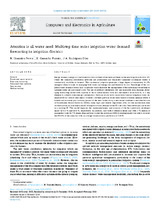Mostrar el registro sencillo del ítem
Attention is all water need: Multistep time series irrigation water demand forecasting in irrigation disctrics
| dc.contributor.author | González Perea, R. | |
| dc.contributor.author | Camacho Poyato, Emilio | |
| dc.contributor.author | Rodríguez-Díaz, Juan Antonio | |
| dc.date.accessioned | 2024-02-12T09:46:35Z | |
| dc.date.available | 2024-02-12T09:46:35Z | |
| dc.date.issued | 2024 | |
| dc.identifier.issn | 0168-1699 | |
| dc.identifier.issn | 1872-7107 | |
| dc.identifier.uri | http://hdl.handle.net/10396/27413 | |
| dc.description.abstract | Energy demand, energy cost and water scarcity are three of the main problems in the new Irrigation districts (ID) where the irrigation distribution networks are pressurized and frequently organized on-demand (water is continuously available to farmers). This on-demand irrigation generates a huge degree of uncertainty for IDs managers when it comes to managing both water and energy use and therefore its cost. Knowledge of the irrigation water demand several days in advance would facilitate the management of the system and would help to optimize water use and energy costs. The use of artificial intelligence (AI) and especially deep learning, developing forecasting model with capacity to learn autonomously from real information from each ID, is a key element to achieve water-energy optimization. Previous works have successfully forecast irrigation water demand at IDs for several days ahead. However, all these previous works were based on human memory which is fallible and not easily pass on from operator to the next. In this work, a new model combined a modified version of Transformer Neural Networks (TNNs), fuzzy logic and Genetic Algorithms (GAs) for the middle-term time resolution forecast (one-week ahead) of irrigation water demand at the ID scale it has been developed and tested in a working ID. This model improves the representativeness and accuracy of the best previously developed model by 6.1 % and 89.8 %, respectively. In addition, only with 9 attention heads and with 1.75 million of parameters (only 16.7 % denser than previous works) the developed IWD forecasting model was able to forecast the 99.9 % of the scenarios with an average standard error prediction of 2.10 %. | es_ES |
| dc.format.mimetype | application/pdf | es_ES |
| dc.language.iso | eng | es_ES |
| dc.publisher | Elsevier | es_ES |
| dc.rights | https://creativecommons.org/licenses/by-nc-nd/4.0/ | es_ES |
| dc.source | González Perea, R., Camacho Poyato, E., & Rodríguez Díaz, J. A. (2024). Attention is all water need: Multistep time series irrigation water demand forecasting in irrigation disctrics. Computers And Electronics In Agriculture, 218, 108723. https://doi.org/10.1016/j.compag.2024.108723 | es_ES |
| dc.subject | Transformer neural networks | es_ES |
| dc.subject | Time series forecasting | es_ES |
| dc.subject | Pressurized water networks | es_ES |
| dc.subject | Deep learning | es_ES |
| dc.subject | Machine learning | es_ES |
| dc.title | Attention is all water need: Multistep time series irrigation water demand forecasting in irrigation disctrics | es_ES |
| dc.type | info:eu-repo/semantics/article | es_ES |
| dc.relation.publisherversion | https://doi.org/10.1016/j.compag.2024.108723 | es_ES |
| dc.relation.projectID | Gobierno de España. PID2020-115998RB-C21/AEI/10.13039/501100011033 | es_ES |
| dc.relation.projectID | Gobierno de España. CEX2019-000968-M | es_ES |
| dc.rights.accessRights | info:eu-repo/semantics/openAccess | es_ES |

